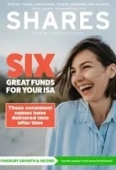Archived article
Please note that tax, investment, pension and ISA rules can change and the information and any views contained in this article may now be inaccurate.
From a childhood fascination with the stock market to success investing through trusts

Former publishing industry professional John is in his 50s and has been investing for decades, starting at a very early age.
John became an investor in his late teens and has started devoting more time to it over the last 20 years. He has always had an interest in markets, even when he was a young boy of seven or eight.
A CHILDHOOD INTEREST IN STOCK MARKET SUCCESSES AND FAILURES
He says: ‘I read the financial pages of the weekend newspapers – in particular, the money section of the Telegraph. I took a great interest in the successes and failures of the stock market.
‘I remember seeing advertisements from the investment trust industry placed in the national newspapers. I do not think they publish these so freely now,’ he adds. ‘The fact is that there would be a graph showing an investment of £10,000 and how it compounded over time and how it was now worth £110,000 or £120,000 more after a couple of decades. I thought that the challenge to myself would be to obtain £10,000 then start investing, so I began saving so I could invest.’
His main motive for investing was and is to create capital and a passive income. He adds: ‘[At that time] I thought if I could create wealth, opportunities and financial independence would follow.’
John says he has invested over the years for several goals including his first home and his child’s education.
‘My objectives have changed over time. But my [premise] for investing has always comes back to the same thing – striving to be financially independent. Financial independence allows you to buy a house, a car or save for retirement.’
WHAT DOES HE HAVE IN HIS PORTFOLIO?
John primarily focuses on investment trusts in his portfolio. He believes they are an ‘excellent collective investment vehicle’ and is reassured by the fact they are run by ‘professional managers’.
He said: ‘I took advice from a family friend incredibly early on who said unless you are extremely wealthy, do not invest in companies directly. Let an investment manager of an investment trust select those shares for you.’
One of the first investments his friend recommended was RIT Capital (RCP) who told him: ‘You can’t go wrong investing alongside Lord Rothschild.’
RIT is a multi-asset portfolio that invests in credit, macro strategies and real assets alongside stocks. It was founded by Jacob (Lord) Rothschild in the early 1960s to serve the English branch of the banking dynasty and while he stepped back as chair in 2019 he remains president of the trust.
John bought shares in February 2001 for 447p, he watched them hit a recent high in January 2021 of £27.50.
John says of this investment: ‘While the share price has dropped in the last 14 months, as a result of a number of factors most of which are outside of the company’s control, the net asset value (NAV) has held up well at around £24.’
He has also invested in Finsbury Growth & Income Trust (FGT) in June 2012 for 333p – which now trades at nearly 850p.
He purchased shares in Baillie Gifford US Growth Trust (USA) in March 2020 at 125p and saw it reach a height of 399p in March of the following year. Since then, the trust has surrendered a large chunk of those gains.
John says: ‘My preferred investment strategy is to buy and hold for the long term allowing compounding to play its part, however, in hindsight how I wish on this occasion I have adopted another strategy.’
DOING THE RESEARCH
John relies on his own research from the Association of Investment Companies (AIC) website and by reading Shares magazine.
‘When I read Shares magazine, I primarily focus on the write ups for investment trusts. I do give a certain amount of time to research, but it is not a full-time job.
‘The fact I’ve been interested in researching for the past 20 years and I’m familiar with most of the investment trusts [is a help] and I definitely know what’s out there.’
John invests in a broad range of investment trusts from different asset classes and from around the world that meet several objectives of capital and income growth. He has noticed that there has been ‘more market volatility over the past 12 months’ and ‘that’s where equity income trusts come into their own’.
John adds: ‘I think when I get sent a dividend from one of those ‘dividend heroes’ I own – which there are a growing number – it either provides a natural yield to my portfolio, I can reinvest or spend the money.’
POUND COST AVERAGING
During periods of volatility, investing a fixed sum regularly could see you benefit from an effect known as ‘pound cost averaging’. This term refers to the way regular investment can iron out the ups and downs in the price of a share over time.
This is because you will end up buying more shares when the price is lower and fewer shares when the price is higher.
AN ADVOCATE FOR STARTING EARLY AND INVESTING REGULARLY
John says if investing is of interest you should ‘start early’ and ideally invest monthly. ‘A fixed amount is a really an effective way to start because of pound cost averaging. Working what you can afford monthly – whether its £25, £50 or £100 a month. Transfer this sum on the day you get paid. We all must take responsibility for our financial security, particularly with pensions. It is a life skill we all need to have [investing effectively].’
DISCLAIMER: Please note, we do not provide financial advice in case study articles, and we are unable to comment on the suitability of the subject’s investments. Individuals who are unsure about the suitability of investments should consult a suitably qualified financial adviser. Past performance is not a guide to future performance and some investments need to be held for the long term. Tax treatment depends on your individual circumstances and rules may change. ISA and pension rules apply.
Important information:
These articles are provided by Shares magazine which is published by AJ Bell Media, a part of AJ Bell. Shares is not written by AJ Bell.
Shares is provided for your general information and use and is not a personal recommendation to invest. It is not intended to be relied upon by you in making or not making any investment decisions. The investments referred to in these articles will not be suitable for all investors. If in doubt please seek appropriate independent financial advice.
Investors acting on the information in these articles do so at their own risk and AJ Bell Media and its staff do not accept liability for losses suffered by investors as a result of their investment decisions.
Issue contents
Editor's View
Feature
Great Ideas
Money Matters
News
- Why interest in Currys could spark further mergers and acquisitions in the sector
- What have the top US fund managers been doing recently?
- XP Power plummets to 10-year low after two successive profit warnings
- YouGov looks in great shape amid talk of move to US listing
- Uber unveils $7 billion buyback as ride hailing firm shocks investors
 magazine
magazine








